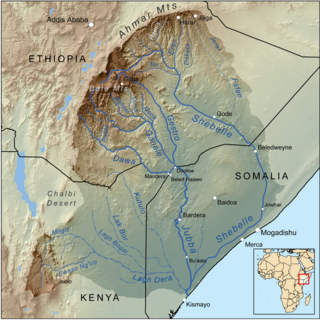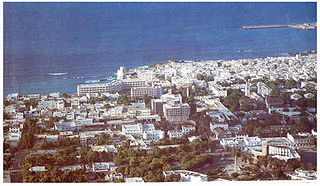
The Jubba River or Juba River is a river in southern Somalia which flows through the autonomous region of Jubaland. It begins at the border with Ethiopia, where the Dawa and Ganale Dorya rivers meet, and flows directly south to the Somali Sea, where it empties at the Goobweyn juncture. The Jubba basin covers an area of 749,000 km2 (289,000 sq mi). The Somali regional state of Jubaland, formerly called Trans-Juba, is named after the river.

The Shebelle River begins in the highlands of Ethiopia, and then flows southeast into Somalia towards Mogadishu. Near Mogadishu, it turns sharply southwest, where it follows the coast. Below Mogadishu, the river becomes seasonal. During most years, the river dries up near the mouth of the Jubba River, while in seasons of heavy rainfall, the river actually reaches the Jubba and thus the ocean.
The Ajuran is a Somali clan, part of the Jambelle clan which itself belongs to one of the largest Somali clan-families — the Hawiye. Ajuran members largely inhabit Kenya as well as southern east Ethiopia; considerable numbers are also found in southern Somalia. Some Ajuran members are settled in Mogadishu.

Merca is the capital city of the Lower Shebelle province of Somalia, a historic port city in the region. It is located approximately 109 km (68 mi) to the southwest of the nation's capital Mogadishu. Merca is the traditional home territory of the Bimal clan and was the center of the Bimal revolt.

The Hawiye is the largest Somali clan family. Members of this clan traditionally inhabit central and southern Somalia, Somaliland, Djibouti, Ethiopia and Kenya. They are also the majority in the capital city, Mogadishu.

The Rahanweyn, also known as the Digil and Mirifle are a major Somali clan. It is one of the major Somali clans in the Horn of Africa, with a large territory and densely populated fertile valleys of the Jubba and Shebelle rivers and the area between are mainly inhabited by settlers from the Digil and Mirifle lineages.

The Ajuran Sultanate, natively referred to as Ajuuraan, and often simply Ajuran, was a medieval Muslim Empire in the Horn of Africa. It rose to power in the 13th century and would dominate the Indian Ocean trade for centuries to come. Founded by Somali Muslim Sultans it ruled over large parts of the Horn of Africa in the Middle Ages. Through a strong centralised administration and an aggressive military stance towards invaders, the Ajuran Empire successfully resisted Portuguese incursions from the east and Oromo invasions from the west.
The Silcis are a Somali subclan. They are part of the Gorgaarte subclan of the Hawiye clan, which is one of the major clans of Somali people. The Silcis inhabit the traditional coastal region of Benadir in the southern part of Somalia. This region should not be confused with the much smaller present day Banaadir administrative region (gobol) which contains Somalia’s capital Mogadishu. Silcis live, or have historically lived, along the Shabeelle River in towns such as Afgooye and Jowhaar, as well as along the coast, especially in Mogadishu and Warsheekh.

Mai-Mai, commonly spelled Maay Maay, is a dialect of the Somali language of the Cushitic branch of the Afro-Asiatic family. It is mainly spoken in Somalia and adjacent parts of Ethiopia and Kenya. In Somalia, it is spoken in South West state, Jubaland state, and Banadir. It is one of the dialects of the Somali language.

Mogadishu is the largest city in Somalia and the nation's capital. Located in the coastal Benadir region on the Indian Ocean, the city has served as an important port for centuries.
Afgooye is a town in the southeastern Somalia Lower Shebelle region of Somalia. It is the center of the Afgooye District. Afgooye is the third largest city of Southwest State. Afgooye is one of the oldest towns on the lower Shebelle valley, 30 kilometers north of Mogadishu. Afgooye is the site of Lafoole college, the first college of education in Somalia, built on the site of the battle of Lafoole of 1896. Afgooye is also known for the Istunka, the annual "stick fight" carnival commemorating the New Year in the riverine region. It was a trade center for the Silcis Dynasty in the medieval period then fell under Ajuran rule. Around the late 17th century, Afgooye became the capital of Geledi Sultanate.

The Bimaal or Bimal, is a sub-clan of the major Dir clan family. This clan is widely known for leading a resistance against the colonials in southern Somalia for decades which can be compared to the war of the Sayyid in Somaliland. The Biimaal mainly lives in southern Somalia, the Somali region of Ethiopia, which their Gaadsen sub-clan mainly inhabits and in the NEP region of Kenya.
Yusuf Mahamud Ibrahim was a Somali ruler. He was the third and most powerful Sultan of the Geledi sultanate, reigning from 1798 to 1848. Under the reign of Sultan Yusuf, his kingdom entered its apex, he managed to modernize his economy and his kingdom quickly became one of the wealthiest states in East Africa. Yusuf frequently toured the sultanate and built rapport with his many clients and allies. He successfully consolidated Geledi power during conquest of Bardera and expelling extremist ideology from his region. It was under his rule he manage to establish many trading partners and allies such as the Sultanate of Witu. He also exacted tribute from Sultan Said of the Omani Empire starting from 1843.
Ahmed Yusuf Mahamud was a Somali Sultan of the Geledi sultanate, reigning from 1848 to 1878 and succeeded his father Yusuf Mahamud after his demise at the battle of Adaddey Suleyman. Ahmed was crowned fourth in line and his rule marked a period of great prosperity in the Sultanate. The Sultan was credited as having brought over 20,000 Somali troops to free the slaves of Zanzibar.

The Sultanate of the Geledi also known as the Gobroon dynasty, was a Somali kingdom that ruled parts of the Horn of Africa during the late-17th century to the early 20th century. The Sultanate was governed by the Gobroon dynasty. It was established by the Geledi soldier Ibrahim Adeer, who had defeated various vassals of the Ajuran Sultanate and elevated the Gobroon to wield significant political power. Following Mahamud Ibrahim's consolidation, the dynasty reached its apex under Yusuf Mahamud Ibrahim, who successfully modernized the Geledi economy and eliminated regional threats with the Conquest of Bardera in 1843, and would go on to receive tribute from Said bin Sultan the ruler of the Omani Empire. Geledi Sultans had strong regional ties and built alliances with the Pate and Witu Sultanates on the Swahili coast. Trade and Geledi power would continue to remain strong until the death of the well known Sultan Ahmed Yusuf in 1878. The sultanate was eventually incorporated into Italian Somaliland in 1911.

Somali architecture is the engineering and designing of multiple different construction types such as stone cities, castles, citadels, fortresses, mosques, temples, aqueducts, lighthouses, towers and tombs during the ancient, medieval and early modern periods in Somalia and other regions inhabited by Somalis, as well as the fusion of Somalo-Islamic architecture with Western designs in contemporary times.

This is a list of Somali aristocratic and court titles that were historically used by the Somali people's various sultanates, kingdoms and empires. Also included are the honorifics reserved for Islamic notables as well as traditional leaders and officials within Somali customary law (xeer), in addition to the nobiliary particles set aside for distinguished individuals.
The Geledi are a Somali clan that live predominantly in the environs of Afgooye city. They are a sub-clan of the Rahanweyn and led the Geledi sultanate during the late 17th to early 20th century. They are divided into two main lineage groups: the Tolweyne and the Yabadhaale.
The Tunni are a Somali clan that make up part of the wider Digil-Rahanweyn branch. It is one of the major clans that inhabit in the South West State of Somalia and can also be found in Jubbaland.
The Tunni Sultanate was a Somali Muslim Sultanate located in southwestern Somalia, south of the Shabelle river. It was ruled by the Tunni people, who spoke the Af-Tunni. The historical Tunni area corresponds to the modern-day Lower Shabelle region.











